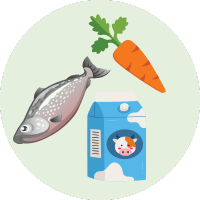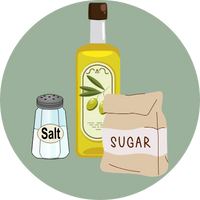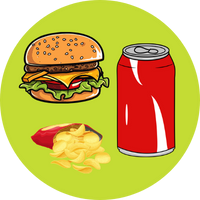Ultra Processed Foods (UPFs)
UPFs damage the human body and increase rates of metabolic disease, heart disease, mental illness and cancer so are worth avoiding.
What are UPFs?
Dr Chris van Tulleken is a specialist in infectious diseases at University College London and has written the book Ultra-Processed People: Why Do We All Eat Stuff That Isn’t Food … and Why Can’t We Stop? In the book he describes UPFs as:
“Processes and ingredients used to manufacture ultra-processed foods are designed to create highly profitable (low-cost ingredients, long shelf life, emphatic branding), convenient (ready-to-consume), hyperpalatable products.”
In other words, they’re designed to maximise profit for the sellers, have little nutritional value and leave people wanting more.
Your wellbeing and health is likely to improve significantly if you cut back on UPFs and focus on having more minimally processed or processed foods (see below).
Group 1
minimally processed foods

Fresh, dry or frozen vegetables or fruit, grain, legumes (e.g. beans), meat, fish, eggs, nuts and seeds
Group 2
processed culinary ingredients

Plant oils (e.g. olive oil, coconut oil), animal fats (e.g. cream, butter, lard), maple syrup, sugar, honey, salt
Group 3
processed foods

Canned / pickled vegetables, meat, fish or fruit; home-made or artisan bread, cheese, salted meats(e.g. ham / salami), wine, beer, cider
Group 4
ultra-processed foods

Sugary drinks, sweet and savoury snacks, reconstituted meat products (e.g. chicken nuggets), ready meals, canned / instant soups, breakfast cereals, supermarket bread, ice cream
Processing includes removal of inedible / unwanted parts. Does not add substances to the original food
Substances derived from Group 1 foods or from nature by processes including pressing, refining, grinding, milling or drying
Processing of foods from Group 1 or Group 2 with the addition of oil, salt or sugar by canning, pickling, smoking, curing or fermentation
Formulations made from a series of processes including extraction and chemical modification. Includes very little intact Group 1 foods
How To Cut Back on Ultra Processed Foods (UPFs)
- Cook from scratch
- Check the labels
- avoid products with hydrolysed proteins, soya protein isolate, gluten, casein, whey protein, mechanically separated meat, fructose, high-fructose corn syrup, fruit juice concentrates, invert sugar, maltodextrin, dextrose, lactose, soluble or insoluble fibre, hydrogenated or interesterified oil.
- Healthy snacks
- fruit, nuts, seeds
- Meal planning
- Make your takeaways
- Breakfast
- if you need to eat cereals then whole grain cereals (e.g. porridge, muesli, granola) are best. Most other cereals are UPFs, as is most supermarket bread.
Cutting back on UPFs doesn’t need to cost the earth. These tips will help you:
- Frozen vegetables and fruit are often cheaper than fresh. For fresh fruit and vegetables, try markets selling supermarket rejects (often slightly the wrong size or funny shapes) or aisle end offers which sometimes have fruit and veg approaching their sell by date.
- Proteins – canned fish, beans, lentils (canned or dried) and eggs are relatively low cost proteins which will have a positive impact on your health. If you can buy in bulk this may be even cheaper.
- Meal planning – planning meals and what to buy can save money through wasting less. There are some apps which can help with this and will even create a final shopping list for you.
- Cook in bulk and freeze – if you’ve got a freezer, then bulk meal preparation can cut down on costs and save time, and make it less likely you’ll grab an unhealthy option if you finish work and feel too tired to cook.

